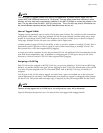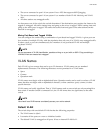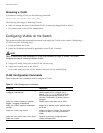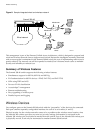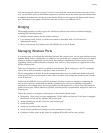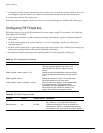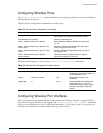
Bridging
Summit 300-48 Switch Software User Guide 75
You can set network policies at Layers 2 and 3 to cover both the wired and wireless networks. In this
way you can block access to individuals suspected of intrusion across the entire network infrastructure.
In addition to traditional wired devices, the Summit 300-48 switch supports the Altitude 300 wireless
port, third party access points, and devices that rely on Power over Ethernet (PoE).
Bridging
The bridging module provides support for wireless-to-wireless and wireless-to-Ethernet bridging,
including the following features:
• Multiple transmit queues for the wireless interface
• User identity-based VLANs, in which each station is associated with a VLAN based on
authentication results
• 802.1p with priority level based on the ToS/DiffServ bit in the IP header
Managing Wireless Ports
It is not necessary to configure the individual Altitude 300 wireless ports. You set port attributes on the
Summit 300-48 switch, copying them as needed to new ports that you configure. Each time you make a
change to wireless configuration on the switch, that change is implemented in the wireless network.
Upgrading wireless software becomes extremely easy, since it is only necessary to upgrade the switch,
not the wireless ports.
There are two interfaces (A and G) available on each Summit 300-48 switch port. All CLI commands
refer to the A radio as interface 1 and the G radio as interface 2.
Device management is flexible. From the management system you can enable and disable individual
wireless ports or sets of ports based on time, user, or location. You manage the wireless ports from the
wired IP network.
Profiles are available for security and RF parameters. Profiles function as templates, eliminating the
need to issue repetitive commands and thereby simplifying the process of updating configuration
information over multiple ports. You assign profiles to each interface (A or G) on a port and share the
profiles across ports. Unless otherwise specified, a default profile is automatically assigned to each new
wireless port.
Follow this process to configure wireless ports on the Summit 300-48 switch:
1 Designate a VLAN as the wireless management VLAN. Make sure that the VLAN port is untagged
between the switch and the Altitude 300 wireless port.
2 Assign IP addresses on this VLAN for each wireless port.
3 Create RF-profiles.
4 Assign an ess-name to the network.
5 Create security profiles and configure security parameters for each.
6 Configure wireless ports on the switch by assigning RF profiles and security profiles.



